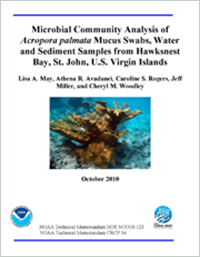-
Home
-
Data & Publications
-
Regional Portals
- About Regional Portals
- Florida
- Navassa Island
- Puerto Rico
- Flower Garden Banks
- U.S. Virgin Islands
- American Samoa
- Commonwealth of the Northern Mariana Islands
- Federated States of Micronesia
- Guam
- Main Hawaiian Islands
- Republic of the Marshall Islands
- Northwestern Hawaiian Islands
- Republic of Palau
- Pacific Remote Island Areas
-
CRCP Activities
- Glossary
Microbial Community Analysis of Acropora palmata Mucus Swabs, Water and Sediment Samples from Hawksnest Bay, St. John, U.S. Virgin Islands

Colonies of the scleractinian coral Acropora palmata, listed as threatened under the US Endangered Species Act in 2006, have been monitored in Hawksnest Bay, within Virgin Islands National Park, St. John, from 2004 through 2010 by scientists with the US Geological Survey, National Park Service, and the University of the Virgin Islands. The focus has been on documenting the prevalence of disease, including white band, white pox (also called patchy necrosis and white patches), and unidentified diseases. In an effort to learn more about the pathologies that might be involved with the diseases that were observed, samples were collected from apparently healthy and diseased colonies in July 2009 for analysis. This paper reports the methodologies used to evaluate the microbial community associated with coral mucus, and the changes those communities may undergo in response to disease. The methods are non-invasive, an advantage which eliminates the need to remove coral sections for study, thus preserving our coral reef sanctuaries.
Citation: May, LA, AR Avadanei, CS Rogers, J Miller, and CM Woodley. 2010. Microbial Community Analysis of Acropora palmata Mucus Swabs, Water and Sediment Samples from Hawksnest Bay, St. John, U.S. Virgin Islands. NOAA Technical Memorandum NOS NCCOS 123 and CRCP 14. 7 pp.
Microbial Community Analysis of Acropora palmata Mucus Swabs, Water and Sediment Samples from Hawksnest Bay, St. John, U.S. Virgin Islands (full report, pdf, 442 KB)
For more information, contact:


